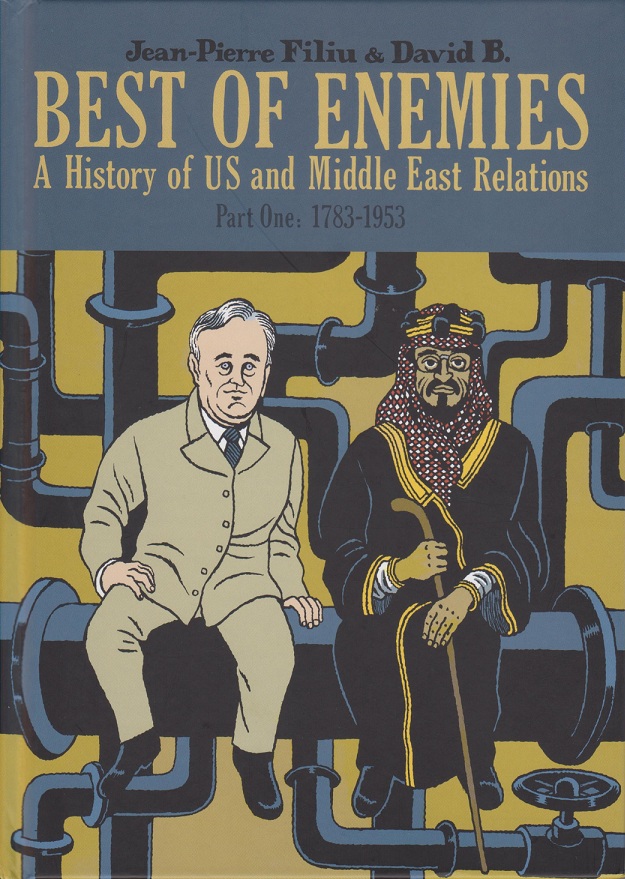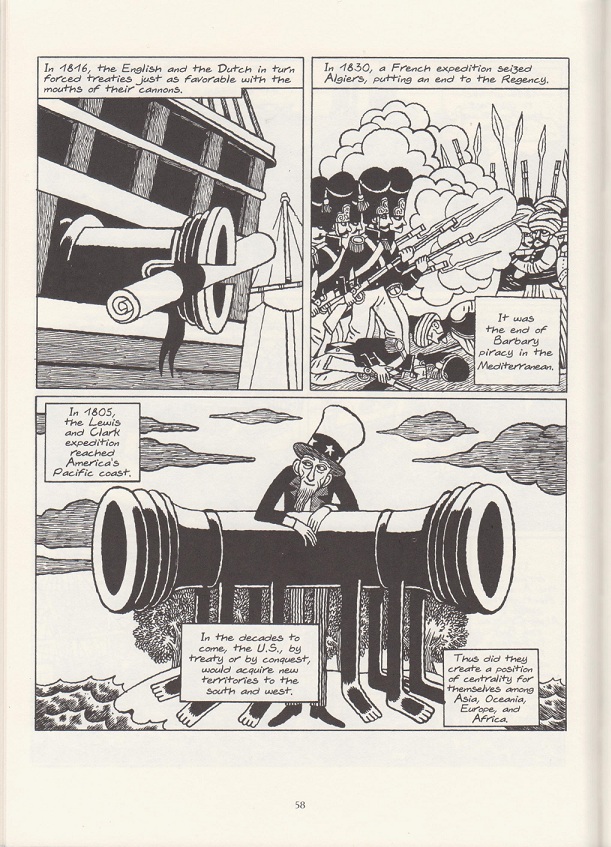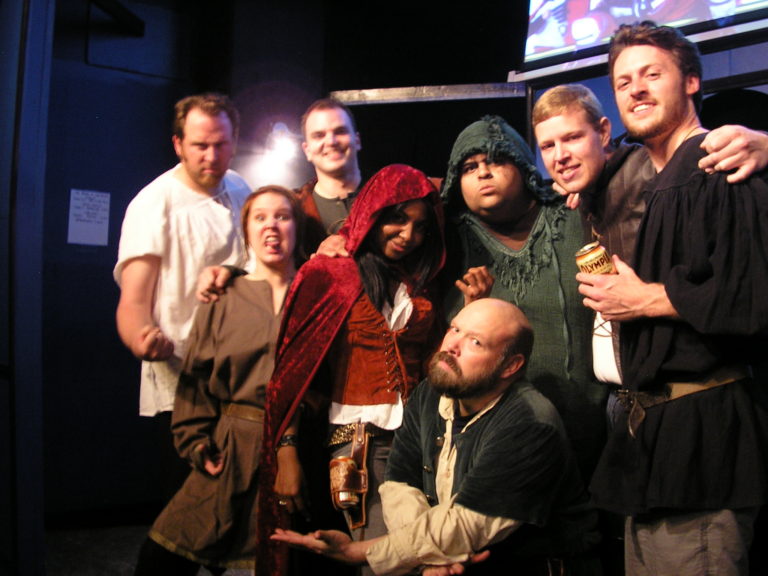 Title: Best of Enemies: A History of US and Middle East Relations
Title: Best of Enemies: A History of US and Middle East Relations
Author: Jean-Pierre Filiu
Artist: David B.
Publisher: Abrams Books/Self Made Hero
Volume: Part 1: 1783-1953, $24.95 (HC, B&W)
Vintage: May 15, 2012 (originally in French by Futuropolis in 2011)
Genre: History, education
Best of Enemies chronicles American and Middle Eastern relations from the time America became, well, America, until the present (with this particular volume covering up to 1953). It’s a time of war, war, and more war. Wars involving a young America, Great Britain, Egypt, Iraq, France, Spain, Saudi Arabia, Muslims, Christians, Turks, Ottomans, and anyone with a vested interest in the lands, waters, and resources of the region. Sometimes the tribes war amongst each other for land and power, other times they’re conquered by invading forces wanting control of strategic pieces of land, and still other times they’re “liberated” from conquerors only to be ruled by their liberators. Expansion, political meddling, corruption fueled by greed, religious manifests…these things have rocked the lands of the Middle East throughout history. When Piracy ruled the Mediterranean, the European countries warred with these pirates to protect their economic interests. Money spoke volumes, ransoming back captured crew members and buying temporary peace. When America broke free from the English monarchy, England did not hide the fact that British ships would no longer protect American ships, encouraging attacks the Americans couldn’t hope to overcome, and leading to the infamous era of the Barbary Pirates. Although America had not yet settled its western lands, they warred with people an ocean away, driving the country near to bankruptcy with expensive tributes and peace offerings. With the different countries vying for the biggest cut to prove their own power, and America’s current stance on slavery (they opposed it in Libya, while practicing it themselves), negotiations were difficult. Eventually, all out war was declared on the US by the Pasha of Tripoli. Without knowledge of the land and water they would be fighting on, the American fleets struggled against an enemy on their own turf. The American fleet had only small victories, mostly ineffectual, and struggled to press forward, even as it went through one commander after another. In 1793, a war of succession broke out in Tripoli, and America decided to back the deceased Ali Karamanli’s second son, Hamet. Eventually, while the Americans focused on their own continent’s expansion, the French put an end to the reign of the Barbary pirates. When America decided to reform relations with the Ottoman Empire, exchanges of money fueled the political economy, while a rush of Christian missionaries flooded their lands. However, America stayed out of the Anglo-French war in the Ottoman Empire, and Great Britain carved the land while President Woodrow Wilson spoke out but was silenced by Congress. Not until World War II did America reinstate its interest in the Middle East, when it went to Saudi Arabia to satisfy its rising oil needs. As part of the agreement, President Roosevelt, who wanted to allow the European Jews immigration rights to Palestine, agreed that no decisions about Palestine would be made without first consulting with Saudi Arabia. Throughout WWI and WWII, British and Russian troops occupied parts of Persia and then Iran to protect their oil investments. Oil quickly became a driving force in the region, and the western countries wasted no time attempting to forge favorable political situations.
 War, money, oil, politics…. Best of Enemies makes quite plain what specific goals and events have shaped the history of the Middle East and its relationship with the western countries. The situation there is far more complicated than can be explained here, to be honest, though Jean-Pierre Filiu does a good job. I’ve been reading a book by former President Jimmy Carter called Palestine: Peace Not Apartheid, and that’s helped a bit with my understanding. It’s sort of unfathomable that America, in its youth, spent so much time warring with nations across the ocean, when so much of its own land was unexplored and unconquered (by America, anyway, since it was all still “conquered” by France and Spain). They kept throwing money at a problem that didn’t seem to have a cause or a definitive solution (and since we’re still screwing around over there, over 200 years later, there still isn’t one). Just based on my own knowledge, because the book isn’t very explanatory on this account, there was a lot of trading going on in the Mediterranean during that time, and lots of new exploration. Though again, why a young country like America was bothering way over there when they had so much unexplored land at home is not clear to me. American vessels were being attacked by pirates, so they fought back for the return of their people and to secure safe passage in the future. Those scuffles led to an investment in the future of the Middle East as time passed and American interests in the area grew (like, for example, its interest in oil; though much earlier its philosophies of manifest destiny). Throughout these pages, country after country interferes with Middle Eastern politics, trying to guide the political climate to best suit their own needs, with little regard for the needs of those living there. It’s kind of sick, really, and while one might wish the West would just leave them alone and let them deal with their own problems, the fact of the matter is that the West caused many of those problems, and bears some responsibility for the current state of the area. Best of Enemies isn’t a perfect account of Western and Middle Eastern relations, but it goes a long way toward explaining the delicate situation that currently exists. It’s also filled with wonderful imagery from the pencil of award-winning French artist David B. Filiu’s words can read like an educational text, but they come to life alongside David B.’s highly detailed black and white artwork, which graces page after page with intriguing artistic metaphors. Much of his imagery speaks volumes all on its own, like cannons emerging from keffiyeh where faces should be, or a pair of swords drawn in place of a mustache on a Pasha. If you’re at all interested in the history of the Middle East, or the West’s political involvement throughout this history, Best of Enemies is a helpful and engaging tool.
War, money, oil, politics…. Best of Enemies makes quite plain what specific goals and events have shaped the history of the Middle East and its relationship with the western countries. The situation there is far more complicated than can be explained here, to be honest, though Jean-Pierre Filiu does a good job. I’ve been reading a book by former President Jimmy Carter called Palestine: Peace Not Apartheid, and that’s helped a bit with my understanding. It’s sort of unfathomable that America, in its youth, spent so much time warring with nations across the ocean, when so much of its own land was unexplored and unconquered (by America, anyway, since it was all still “conquered” by France and Spain). They kept throwing money at a problem that didn’t seem to have a cause or a definitive solution (and since we’re still screwing around over there, over 200 years later, there still isn’t one). Just based on my own knowledge, because the book isn’t very explanatory on this account, there was a lot of trading going on in the Mediterranean during that time, and lots of new exploration. Though again, why a young country like America was bothering way over there when they had so much unexplored land at home is not clear to me. American vessels were being attacked by pirates, so they fought back for the return of their people and to secure safe passage in the future. Those scuffles led to an investment in the future of the Middle East as time passed and American interests in the area grew (like, for example, its interest in oil; though much earlier its philosophies of manifest destiny). Throughout these pages, country after country interferes with Middle Eastern politics, trying to guide the political climate to best suit their own needs, with little regard for the needs of those living there. It’s kind of sick, really, and while one might wish the West would just leave them alone and let them deal with their own problems, the fact of the matter is that the West caused many of those problems, and bears some responsibility for the current state of the area. Best of Enemies isn’t a perfect account of Western and Middle Eastern relations, but it goes a long way toward explaining the delicate situation that currently exists. It’s also filled with wonderful imagery from the pencil of award-winning French artist David B. Filiu’s words can read like an educational text, but they come to life alongside David B.’s highly detailed black and white artwork, which graces page after page with intriguing artistic metaphors. Much of his imagery speaks volumes all on its own, like cannons emerging from keffiyeh where faces should be, or a pair of swords drawn in place of a mustache on a Pasha. If you’re at all interested in the history of the Middle East, or the West’s political involvement throughout this history, Best of Enemies is a helpful and engaging tool.
Kris
kristin@comicattack.net
@girlg33k_kris
Review copy provided by Abrams Books.

